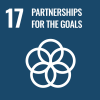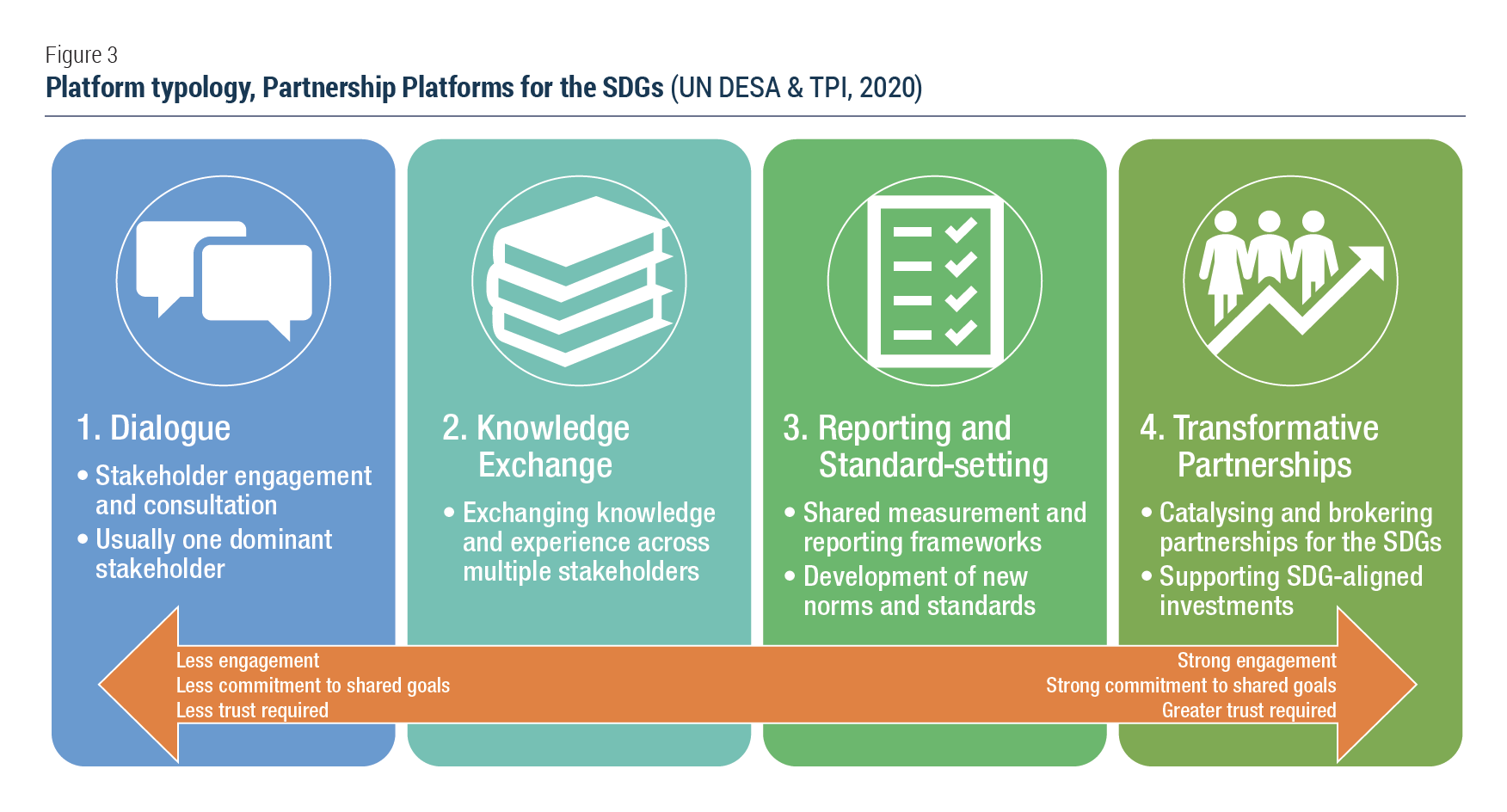
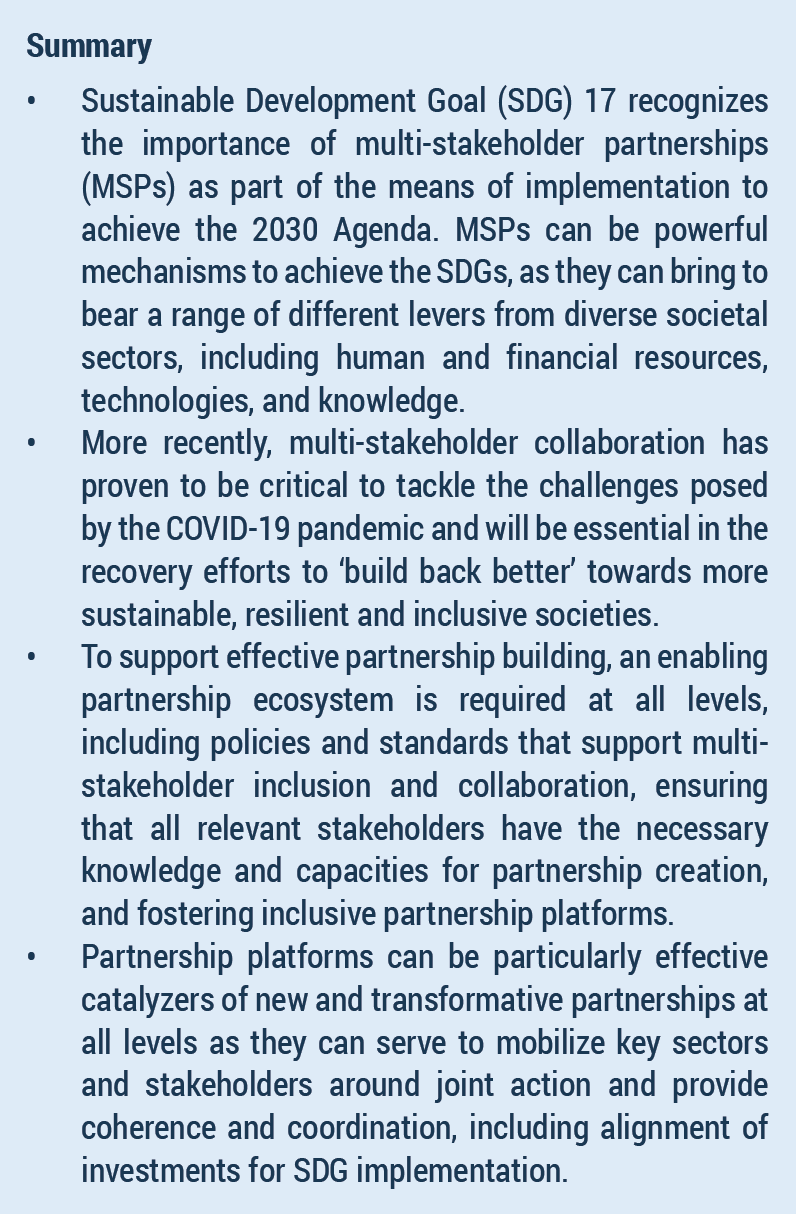 Introduction
Introduction
The 2030 Agenda for Sustainable Development is built on a fundamental shift in approach to development as it seeks to engage the unique roles and resources of all sectors of society, and requiring extensive collaboration across sectors to achieve its ambitious goals. Partnerships for the Sustainable Development Goals (SDGs) are multi-stakeholder initiatives voluntarily undertaken by Governments, intergovernmental organizations, and other stakeholders, and whose efforts are contributing to the implementation the 2030 Agenda. SDG 17, which reads “Strengthen the means of implementation and revitalize the Global Partnership for Sustainable Development”, recognizes multi-stakeholder partnerships (MSPs) as important vehicles for mobilizing and sharing knowledge, expertise, technologies and financial resources to support the achievement of the SDGs in all countries, particularly developing countries. Goal 17 further seek to encourage and promote effective public, public-private and civil society partnerships, building on the experience and resourcing strategies of partnerships. 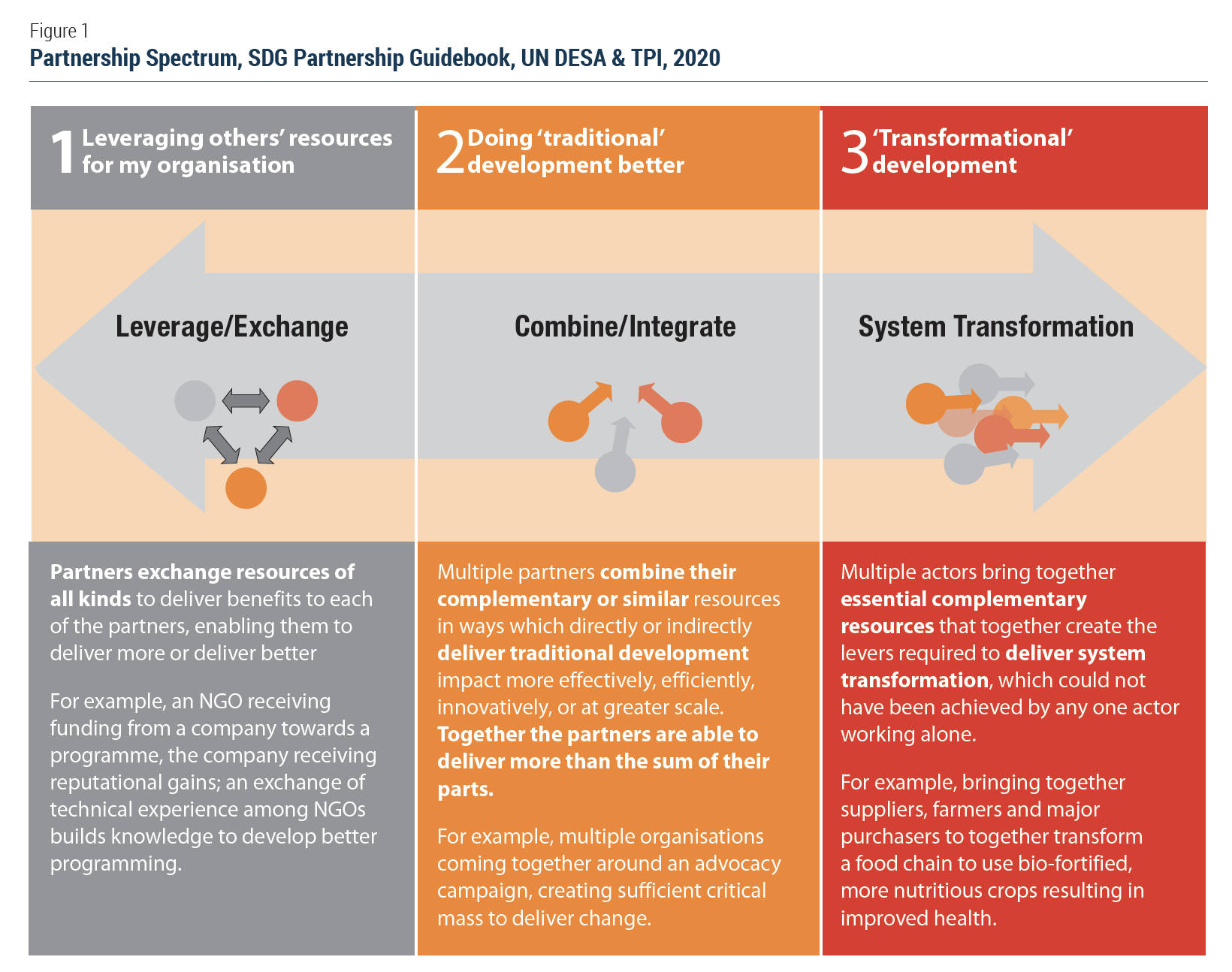 MSPs can range from networks made up of hundreds of organizations through to joint ventures between two or three entities. This broad definition encompasses a multitude of types of collaborative arrangement with quite different scopes. The figure below shows a ‘Partnership Spectrum’ as a way of visualizing the range of different collaborative arrangements that fit within this definition. Transformational partnerships for the SDGs are those that deliver system shifts to move from an unsustainable (either economically, socially or environmentally) system, to a more sustainable one. Such partnerships are characterized by multiple actors bringing together essential complementary resources that together create the levers required to deliver system transformation, which could not have been achieved by any one actor working alone.
MSPs can range from networks made up of hundreds of organizations through to joint ventures between two or three entities. This broad definition encompasses a multitude of types of collaborative arrangement with quite different scopes. The figure below shows a ‘Partnership Spectrum’ as a way of visualizing the range of different collaborative arrangements that fit within this definition. Transformational partnerships for the SDGs are those that deliver system shifts to move from an unsustainable (either economically, socially or environmentally) system, to a more sustainable one. Such partnerships are characterized by multiple actors bringing together essential complementary resources that together create the levers required to deliver system transformation, which could not have been achieved by any one actor working alone. 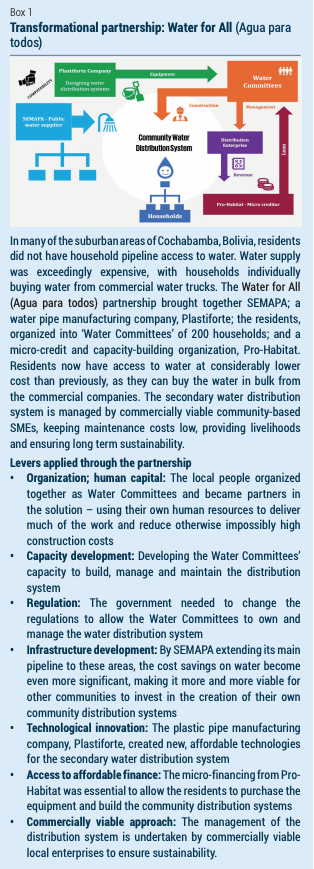 The 2019 Global Sustainable Development Report (GSDR) recognizes that major transformations in areas like energy systems, health, food and urbanization make it necessary to radically rethink partnerships between science, government, the private sector, civil society and more. The report also notes that rapid change can only happen when different actors work together in an integrated way towards shared goals through strategic partnerships, and by sharing and applying available scientific, technological and policymaking knowledge.
The 2019 Global Sustainable Development Report (GSDR) recognizes that major transformations in areas like energy systems, health, food and urbanization make it necessary to radically rethink partnerships between science, government, the private sector, civil society and more. The report also notes that rapid change can only happen when different actors work together in an integrated way towards shared goals through strategic partnerships, and by sharing and applying available scientific, technological and policymaking knowledge.
Experiences from COVID-19
The COVID-19 pandemic has further underscored the importance of enhancing global collaboration and building effective partnerships among all sectors and stakeholders, while building back better, together. In the face of the significant challenges imposed by the pandemic and the deep economic recession it has yielded, the global community has made significant efforts to mobilize new partnerships from all stakeholders The year 2020 witnessed a growing number and scope of MSPs which aim to address the various challenges brought by the pandemic, from developing vaccines and providing urgent health and socio-economic responses to the pandemic, to supporting communities to live with the pandemic and working towards a post-pandemic sustainable recovery. A recent study by UN DESA on “Partnerships in response to COVID-19 - Building back better together” shows that:
• A wide range of types of partnerships have been formed during the pandemic, most of which have been focusing on the immediate response to the pandemic.
• Partnerships during the pandemic have provided technical assistance; supported direct project implementation and delivery; facilitated research; provided financial support for non-research partnerships; carried out data and analytics; and coordinated international COVID-19 response actions.
• A wide range of institutions have initiated partnerships during the pandemic, with the United Nations and the private sector playing a leading role. A prominent example is the ACT Accelerator - a ground-breaking global collaboration to accelerate the development, production, and equitable access to COVID-19 tests, treatments, and vaccines.
• The sense of urgency, existing networks and previous partnership experiences, the use of digital technologies, and adoption of innovative practices have been important factors facilitating the speedy formation of partnerships during the pandemic.
• Key success factors of COVID-19 responsive partnerships have included leadership and vision, trust, alignment of interests, flexibility, commitment, and adaptive governance structures.
• Communication between partners, access to key financial and human resources, and uncertainty given the rapidly changing conditions have been some of the major challenges in the creation and management of partnerships during the pandemic.
Partnership platforms for the SDGs
It is partnerships at the global, national, sub- national and city level – those that can best harness and optimize the resources available – that will drive forward the real change required to deliver the SDGs and impact people’s lives for the better. In this regard, a fundamental challenge will be to ensure systematic collaboration by different societal sectors toward delivering the shared vision of the SDGs. Partnership platforms for the SDGs are emerging as key mechanisms for brokering new partnerships, providing coherence and coordination among stakeholders, and aligning investments for SDG implementation. Such platforms are being developed around the world, including in Kenya, Uganda, and Samoa, among others, and appear to have great potential to accelerating progress towards the SDGs. The following typology illustrates how partnership platforms are distinct from other multi-stakeholder mechanisms: While there are hundreds of examples across the first three categories, there are relatively few platforms that fit in the last category. It should be noted that this typology does not constitute a value judgement. Dialogue platforms, for example, can play an essential role in building trust between stakeholders and have an influence on the policy and regulatory environment. However, there is a hierarchy of function: each category includes and builds on the previous category. A ‘knowledge exchange’ platform, for example, will have some element of dialogue as well; and a standard-setting platform will contain both knowledge exchange and dialogue functions. 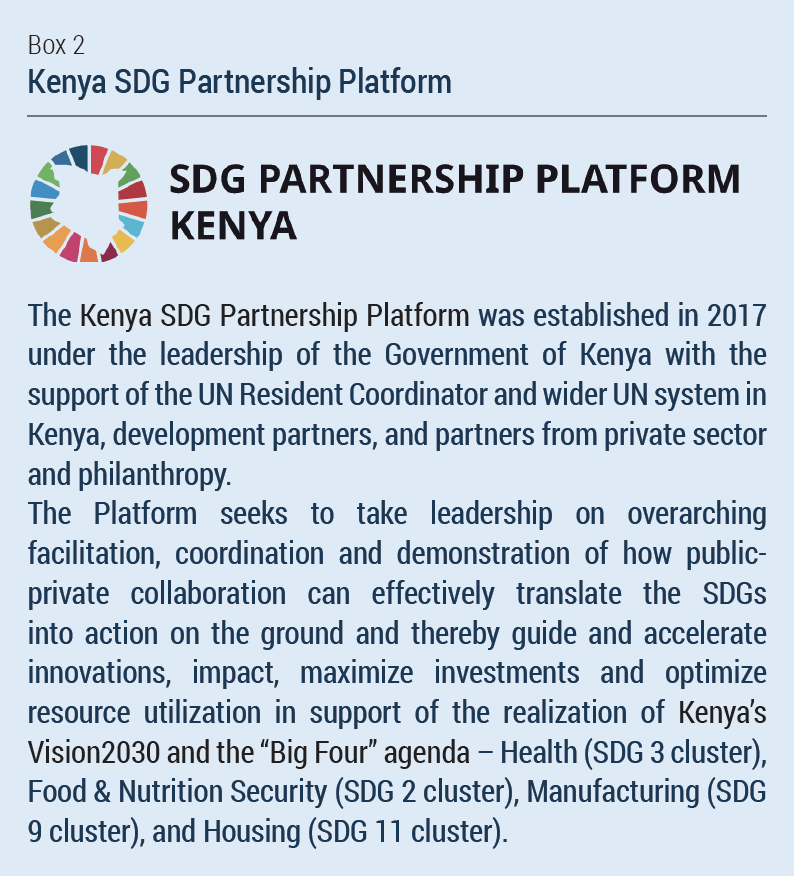 The critical distinction is that transformational partnership platforms go beyond dialogue and knowledge exchange and focus on catalyzing and implementing partnerships. Such partnership platforms are characterized by the following elements:
The critical distinction is that transformational partnership platforms go beyond dialogue and knowledge exchange and focus on catalyzing and implementing partnerships. Such partnership platforms are characterized by the following elements:
• Convening and dialogue: bringing together key stakeholders from across sectors around issues of common interest
• Partnership brokering: active fostering of partnerships between stakeholders around priority issues
• SDG-aligned investments: providing a mechanism to align aid, foreign direct investment, philanthropy, domestic financing and other forms of capital in ways that contribute to the SDGs
• Building an enabling environment: advocating for a common agenda across societal sectors, as well as strengthening the enabling environment for collaboration at all levels
• Coordinated commitment to action: enabling stakeholders to commit to a common plan, while ensuring mutual accountability and responsibility for delivery.
Building an enabling ecosystem for partnerships
To support effective partnerships building, an enabling ecosystem is required at all levels. This includes policies and standards that support multi-stakeholder inclusion and collaboration, ensuring that all relevant stakeholders have the necessary knowledge and skills for partnership creation, and fostering partnership platforms that can bring different actors together and catalyze new partnerships and actions across sectors. At the global level, there are a number of United Nations mechanisms and processes that support a growing network of institutions and organizations seeking to drive implementation of the SDGs through inclusive partnerships. These include the High-level Political Forum on Sustainable Development, the ECOSOC Partnership Forum, the SIDS Partnership Framework, and the Technology Facilitation Mechanism, amongst others. 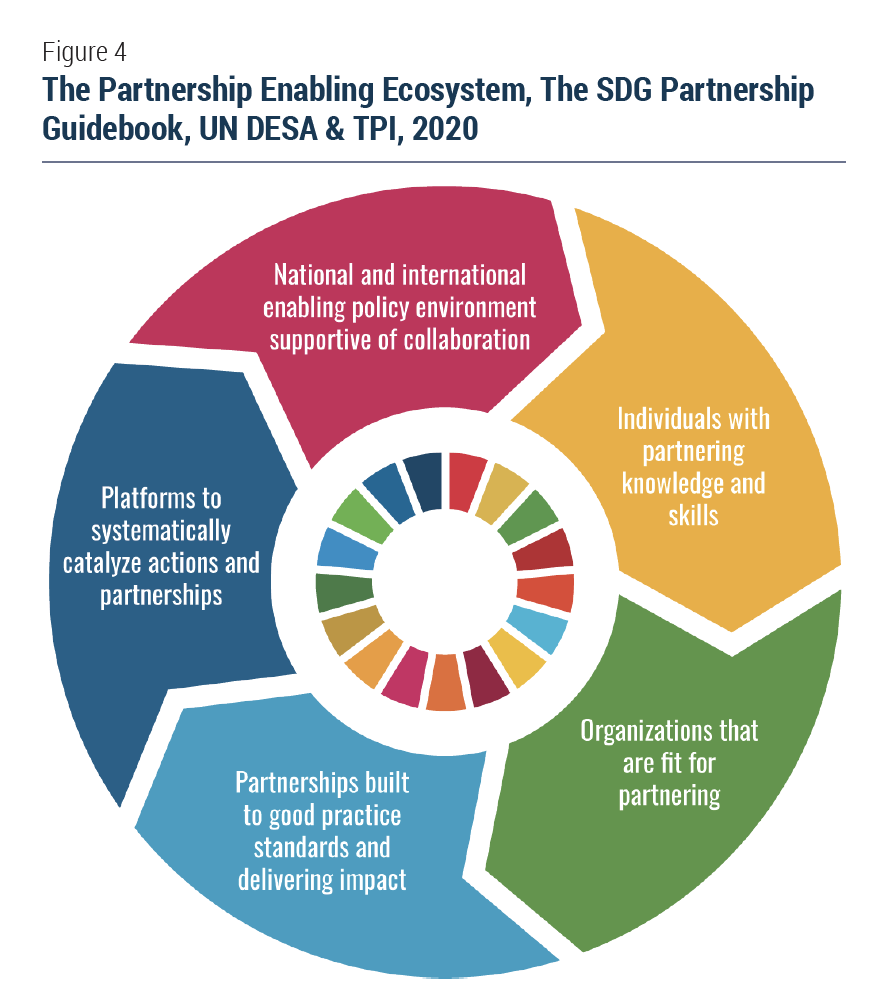 At the national level, the Voluntary National Reviews (VNRs) prepared by Member States on their implementation of the 2030 Agenda can serve as important vehicles for mobilizing multi-stakeholder support and partnerships. VNRs make possible the sharing of experiences, including successes, challenges and lessons learned, and are a key part of the overall follow-up and review of the 2030 Agenda for Sustainable Development. Research by UN DESA of the VNRs presented between 2016 and 2019 has shown that around 75% of countries reported on the inclusion of non-state actors in related governance mechanisms, including high-level coordination or governance mechanisms, technical committees or working groups, as well as explicit commitments to engage with non-state actors through, for example, advisory bodies. Partnerships also play a crucial role for the United Nations at the country level, where Resident Coordinators have the overall responsibility to lead UN country teams in ensuring system-wide accountability of the UN Sustainable Development Cooperation Framework – the instrument for planning and implementation of the UN development activities at country level. The framework is embodied by a spirit of partnerships with the national government, civil society, academia, parliaments, the private sector, and bilateral partners to leverage strengths and drive transformative change on the ground.
At the national level, the Voluntary National Reviews (VNRs) prepared by Member States on their implementation of the 2030 Agenda can serve as important vehicles for mobilizing multi-stakeholder support and partnerships. VNRs make possible the sharing of experiences, including successes, challenges and lessons learned, and are a key part of the overall follow-up and review of the 2030 Agenda for Sustainable Development. Research by UN DESA of the VNRs presented between 2016 and 2019 has shown that around 75% of countries reported on the inclusion of non-state actors in related governance mechanisms, including high-level coordination or governance mechanisms, technical committees or working groups, as well as explicit commitments to engage with non-state actors through, for example, advisory bodies. Partnerships also play a crucial role for the United Nations at the country level, where Resident Coordinators have the overall responsibility to lead UN country teams in ensuring system-wide accountability of the UN Sustainable Development Cooperation Framework – the instrument for planning and implementation of the UN development activities at country level. The framework is embodied by a spirit of partnerships with the national government, civil society, academia, parliaments, the private sector, and bilateral partners to leverage strengths and drive transformative change on the ground.
 Welcome to the United Nations
Welcome to the United Nations
